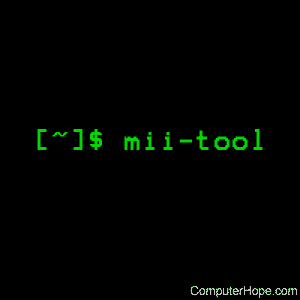Linux mii-tool command
Updated: 05/04/2019 by Computer Hope

On Linux operating systems, the mii-tool utility checks or sets the status of a network interface's MII (Media Independent Interface) unit. Many Ethernet adapters use an MII to autonegotiate link speed and duplex setting.
Syntax
mii-tool [-v, --verbose] [-V, --version] [-R, --reset] [-r, --restart]
[-w, --watch] [-l, --log] [-A, --advertise=media,...]
[-F, --force=media] [interface ...]
Options
| -v, --verbose | Display more detailed MII status information. If used twice, also display raw MII register contents. |
| -V, --version | Display program version information. |
| -R, --reset | Reset the MII to its default configuration. |
| -r, --restart | Restart autonegotiation. |
| -w, --watch | Watch interface(s) and report changes in link status. The MII interfaces are polled at one second intervals. |
| -l, --log | Used with -w, records link status changes in the system log instead of printing on standard output. |
| -F media, --force=media |
Disable autonegotiation, and force the MII to either 100baseTx-FD, 100baseTx-HD, 10baseT-FD, or 10baseT-HD operation. |
| -A media,..., --advertise=media,... |
Enable and restart autonegotiation, and advertise only the specified media technologies. Multiple technologies should be separated by commas. Valid media are 100baseT4, 100baseTx-FD, 100baseTx-HD, 10baseT-FD, and 10baseT-HD. |
Examples
mii-tool -v
Displays information similar to the example output below.
product info: Yukon 88E1011 rev 4 basic mode: autonegotiation enabled basic status: autonegotiation complete, link ok capabilities: 1000baseT-FD 100baseTx-FD 100baseTx-HD 10baseT-FD 10baseT-HD advertising: 1000baseT-HD 1000baseT-FD 100baseTx-FD 100baseTx-HD 10baseT-FD 10baseT-HD flow-control link partner: 1000baseT-FD 100baseTx-FD 100baseTx-HD 10baseT-FD 10baseT-HD
Related commands
ifconfig — View or modify the configuration of network interfaces.
